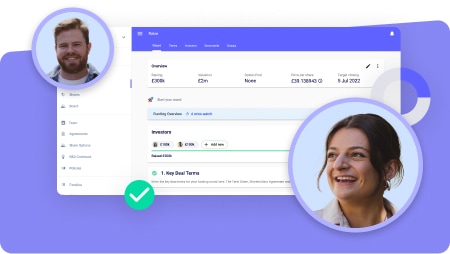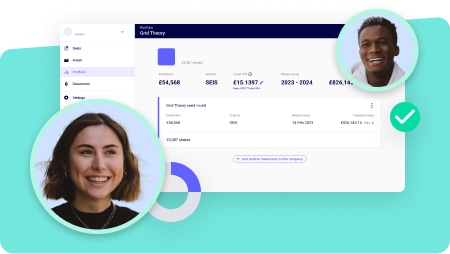R&D tax credit calculator
Spent money developing a new product or service? You could be eligible to claim back up to 33% of your research and development spend from HMRC.
Estimate your R&D tax credit claim and see how much you could get back under the SME scheme.



How much R&D can you claim?
-
Profit makingLoss making
-
£
-
£
-
£
-
£
We estimate you could get back up to
Can my startup claim R&D tax credits?
Many companies don’t realise they’re spending money on activities that qualify for R&D tax relief. That means they miss out on a cash boost or a reduction in their tax bill.
If you’ve invested time and resources into developing a new product or service – or even tried to improve something that already exists – you could be eligible to claim back up to 33% of your R&D spend from HMRC under the SME scheme. Larger companies can claim under the RDEC scheme.
As an SME, the type and amount of R&D tax relief you can claim depends on how much you’ve spent, what you’ve spent it on and whether your company is making a profit or not.
If you’re loss-making
You could claim up to 33% of your R&D spend as a direct cash payment.
If you’re profit-making
You could reduce your Corporation Tax bill by around 25% of your R&D expenditure. Or receive a refund for overpaid tax.
Simply enter the rough figures for your expenses into our R&D SME tax credit calculator to see what you could claim.
You invested in R&D.
Let's get your money back.
Calculate your R&D claim
Maximise your claim
Get your money back
We're here to help
Not sure if your project counts as R&D or which costs you can claim for? Our team of R&D experts is standing by to help. Book a time to talk through your claim and get your questions answered.
Talk to us your way - chat, phone, email, video call
Get unlimited help - no billable hours, no extra cost
Ask us anything - we're here 9am til 6pm Mon - Fri

98%
success rate
£42k
claimed on average
Unlimited
expert help
What else do I need to know about my R&D tax credit calculation?
How do R&D tax credits work?
R&D tax credits are a form of tax relief designed to boost innovation in the UK. They encourage companies to spend money on developing new products and services.
If you meet the qualifying criteria, you can claim back a percentage of the amount you’ve spent on R&D activities. If your claim is successful, you’ll either get cash, a reduction in your tax bill or a refund on overpaid tax.
There are two R&D schemes: one for smaller companies with under 500 employees (SME) and one for larger companies (RDEC).
Our R&D tax credit calculator estimates the tax relief you can claim under the SME scheme. This is the scheme that covers most startups, and it offers a higher rate of tax relief.
Go to our ultimate guide to R&D tax credits to find out more about the differences between the SME and RDEC schemes.Is R&D tax credit worth it?
Yes! R&D tax credits are often overlooked as a source of cash flow for businesses. They’re a helpful way to get extra value from money you’ve already spent - whether it comes as cash or a reduction in your tax bill. And best of all, you can claim even if your project wasn’t successful.
We know that the process and calculations involved can seem overwhelming and complicated. When you build your R&D tax credits claim on SeedLegals, we’ll do all the heavy lifting. Just answer a few questions, import your costs and we’ll do the rest.What are the R&D tax credit rates?
This depends on the size of your company and whether you’re profitable or not.
Small and medium-sized businesses (under 500 employees) that are making a loss can claim back up to 33% of their R&D spend. Claims for profitable SMEs will typically be around 25% of total R&D spend.
Larger companies can claim just over 10% of their R&D spend under the RDEC scheme.How do I calculate R&D tax credits?
You can see full R&D tax credit calculation examples in the how to calculate R&D tax credit section of our ultimate guide.
Here’s a quick summary for a hypothetical loss-making SME called LeedSegals. LeedSegals have recently spent £100,000 on software development.
First, LeedSegals needs to calculate their enhanced expenditure figure. All companies can deduct 100% of eligible R&D costs from their tax liabilities. But companies that qualify for the SME scheme get an additional 130% – this is called the ‘uplift’.
When they add this 130% uplift to the default 100%, they get the enhanced expenditure amount of 230%. They multiply their eligible R&D expenditure of £100,000 by 230% to get £230,000. This is the figure on which the value of their R&D payable tax credits will be calculated.
Because LeedSegals is loss-making, they have to decide whether to surrender the loss for immediate cash credit or carry it forward to offset a future tax bill in a profitable period. They choose to surrender, and multiply their enhanced expenditure figure of £230,000 by the surrender rate of 14.5% to get £33,350.
Result: LeedSegals claims £33,350 in cash credit - 33% of their R&D spend.How and when can I claim R&D tax credits?
To claim R&D tax relief, you need to file an R&D claim with HMRC detailing the amount you’ve spent on R&D projects. You’ll submit this claim at the same time as you file your Corporation Tax return.
You can also claim R&D tax relief for the previous two accounting periods by submitting an amended tax return. For example, if your accounting year end is 31 December 2022, you have until 31 December 2024 to submit your claim.What counts as an R&D project?
To qualify for R&D tax relief, you don’t have to invent a brand new product or process. Most of the claims that we see involve an ‘appreciable’ improvement to existing technology. You need to demonstrate that this improvement was not straightforward and that you faced 'technological uncertainty' trying to achieve it.
To pass HMRC’s bar for a qualifying R&D project, you’ll need to show that:- you looked for an advance in a field of science or technology
- you had to overcome scientific or technological uncertainty
- the solution to the uncertainty was not readily deducible to a competent professional in a relevant field of science or technology
Find out more in our guide to R&D eligibility criteria.What expenses qualify for R&D tax credits?
For full details, see this list of qualifying expenses in our ultimate guide to R&D.
In general, you can claim for:
Staff costs- Gross salaries
- Employer NI contributions
- Employer pension contributions
- Bonuses (paid within 9 months of the financial year end)
- Any reimbursed expenses relating to the R&D project
Subcontractor and third party costs- Including any work subcontracted out to a company, individual or other organisation
- Externally provided workers, for example agency workers who contributed to the R&D effort
Consumable items- Costs of raw materials used or transformed during the R&D process (these can’t be sold on or form part of the final sellable product)
- Utilities costs such as water, gas, electricity
Software costs- Any licence costs for software used in R&D activities (eg CAD/CAM/GitHub)
It can be difficult to separate qualifying costs from non-qualifying costs. If you use SeedLegals to build your R&D claim, we’ll go over all your costs with you and make sure your claim is accurate.
R&D insights from our experts

R&D tax credits: The ultimate guide for 2022
How do R&D tax credits work? Are you missing out on tax relief? Find out how to claim back up to 33% of your R&D spend.

Can grants and R&D tax credits be used together?
As a startup, you’re probably constantly in search of funding to fuel your business. Can grants and R&D tax credits can be used together?











